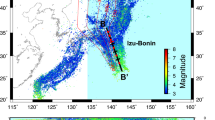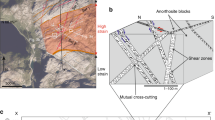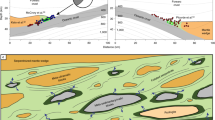Abstract
Intermediate-depth earthquakes1, at depths of 50–300 km in subduction zones, occur below the brittle–ductile transition, where high pressures render frictional failure unlikely. Their location approximately coincides with 600 to 800 °C isotherms in thermal models2, suggesting a thermally activated mechanism for their origin. Some earthquakes may occur by frictional failure owing to high pore pressure that might result from metamorphic dehydration2,3,4,5. Because some intermediate-depth earthquakes occur ∼30 to 50 km below the palaeo-sea floor6, however, the hydrous minerals required for the dehydration mechanism may not be present. Here we present an alternative mechanism to explain such earthquakes, involving the onset of highly localized viscous creep in pre-existing, fine-grained shear zones. Our numerical model uses olivine flow laws for a fine-grained, viscous shear zone in a coarse-grained, elastic half space, with initial temperatures from 600–800 °C and background strain rates of 10-12 to 10-15 s-1. When shear heating becomes important, strain rate and temperature increase rapidly to over 1 s-1 and 1,400 °C. The stress then drops dramatically, followed by low strain rates and cooling. Continued far-field deformation produces a quasi-periodic series of such instabilities.
This is a preview of subscription content, access via your institution
Access options
Subscribe to this journal
Receive 51 print issues and online access
$199.00 per year
only $3.90 per issue
Buy this article
- Purchase on Springer Link
- Instant access to full article PDF
Prices may be subject to local taxes which are calculated during checkout




Similar content being viewed by others
References
Kirby, S. H., Engdahl, E. R. & Denlinger, R. P. in Subduction Top to Bottom (eds Bebout, G. E., Scholl, D. W., Kirby, S. H. & Platt, J. P.) 195–214 (Geophysical Monograph 96, American Geophysical Union, Washington DC, 1996)
Peacock, S. Are the lower planes of double seismic zones caused by serpentine dehydration in subducting oceanic mantle? Geology 29, 299–302 (2001)
Raleigh, C. B. Tectonic implications of serpentinite weakening. Geophys. J. R. Astron. Soc. 14, 113–118 (1967)
Hacker, B. R., Peacock, S. M., Abers, G. A. & Holloway, S. D. Subduction factory 2: Are intermediate-depth earthquakes in subducting slabs linked to metamorphic dehydration reactions? J. Geophys. Res. 108 doi: 10.1029/2001JB001129 (2003)
Jung, H., Green, H. W. & Dobrzhinetskaya, L. F. Intermediate-depth earthquake faulting by dehydration embrittlement with negative volume change. Nature 428, 545–549 (2004)
Igarashi, T., Matsuzawa, T., Umino, N. & Hasegawa, A. Spatial distribution of focal mechanisms for interplate and intraplate earthquakes associated with the subducting Pacific plate beneath northeastern Japan arc: A triple-planed deep seismic zone. J. Geophys. Res. 106, 2177–2191 (2001)
Kelemen, P. B. & Dick, H. J. B. Focused melt flow and localized deformation in the upper mantle: Juxtaposition of replacive dunite and ductile shear zones in the Josephine peridotite, SW Oregon. J. Geophys. Res. 100, 423–438 (1995)
Jaroslow, G. E., Hirth, G. & Dick, H. J. B. Abyssal peridotite mylonites: Implications for grain-size sensitive flow and strain localization in the oceanic lithosphere. Tectonophysics 256, 17–37 (1996)
Newman, J., Lamb, W. M., Drury, M. R. & Vissers, R. L. M. Deformation processes in a peridotite shear zone: Reaction softening by an H2O-deficient, continuous net transfer reaction. Tectonophysics 303, 193–222 (1999)
Christensen, D. H. & Ruff, L. Seismic coupling and outer rise earthquakes. J. Geophys. Res. 93, 13421–13444 (1988)
Savage, J. C. The mechanics of deep-focus faulting. Tectonophysics 8, 115–127 (1969)
Warren, J. & Hirth, G. Grain size sensitive deformation mechanisms in naturally deformed peridotites. Earth Planet. Sci. Lett. (submitted).
Evans, B., Renner, J. & Hirth, G. A few remarks on the kinetics of static grain growth in rocks. Int. J. Earth Sci. 90, 88–103 (2001)
Obata, M. & Karato, S.-I. Ultramafic pseudotachylite from the Balmuccia peridotite, Ivrea-Verbano zone, northern Italy. Tectonophysics 242, 313–328 (1995)
Kanamori, H., Anderson, D. L. & Heaton, T. H. Frictional melting during the rupture of the 1994 Bolivian earthquake. Science 279, 839–842 (1998)
Whitehead, J. A. & Gans, R. F. A new, theoretically tractable earthquake model. Geophys. J. R. Astron. Soc. 39, 11–28 (1974)
Hobbs, B. E., Ord, A. & Teyssier, C. Earthquakes in the ductile regime? Pure Appl. Geophys. 124, 309–336 (1986)
Ogawa, M. Shear instability in a viscoelastic material as the cause of deep focus earthquakes. J. Geophys. Res. 92, 13801–13810 (1987)
Karato, S.-I. Rheological structure and deformation of subducted slabs in the mantle transition zone; implications for mantle circulation and deep earthquakes. Phys. Earth Planet. Inter. 127, 83–108 (2001)
Green, H. W. & Marone, C. in Plastic Deformation of Minerals and Rocks (eds Bercovici, D. & Karato, S.) 181–199 (Rev. Mineral. Geochem. 51, Mineralogical Society of America & the Geochemical Society, Washington DC, 2002)
Bercovici, D. & Karato, S.-I. in Plastic Deformation of Minerals and Rocks (eds Karato, S. & Wenk, H. R.) 387–421 (Rev. Mineral. Geochem. 51, Mineralogical Society of America & the Geochemical Society, Washington DC, 2002)
Branlund, J. M., Kameyama, M. C., Yuen, D. A. & Kaneda, Y. Effects of temperature-dependent thermal diffusivity on shear instability in a viscoelastic zone: Implications for faster ductile faulting and earthquakes in the spinel stability field. Earth Planet. Sci. Lett. 182, 171–185 (2000)
Kameyama, M. C., Yuen, D. A. & Fujimoto, H. The interaction of viscous heating with grain-size dependent rheology in the formation of localized slip zones. Geophys. Res. Lett. 168, 159–162 (1997)
Kameyama, M. C., Yuen, D. A. & Karato, S.-I. Thermal-mechanical effects of low temperature plasticity (the Peierls mechanism) on the deformation of a viscoelastic shear zone. Earth Planet. Sci. Lett. 168, 159–162 (1999)
Regenauer-Lieb, K. & Yuen, D. A. Modeling shear zones in geological and planetary sciences: Solid- and fluid-thermal-mechanical approaches. Earth Sci. Rev. 63, 295–349 (2003)
Hirth, G. & Kohlstedt, D. in Inside the Subduction Factory (ed. Eiler, J.) 83–105 (Geophysical Monograph 138, American Geophysical Union, Washington DC, 2003)
Goetze, G. The mechanisms of creep in olivine. Phil. Trans. R. Soc. Lond. A 288, 99–119 (1978)
van der Wal, D., Chopra, P., Drury, M. R. & Fitz-Gerald, J. Relationships between dynamically recrystallized grain size and deformation conditions in experimentally deformed olivine rocks. Geophys. Res. Lett. 20, 1479–1482 (1993)
Jiao, W., Silver, P. G., Fei, Y. & Prewitt, C. T. Do intermediate- and deep-focus earthquakes occur on preexisting weak zones? An examination of the Tonga subduction zone. J. Geophys. Res. 105, 28125–28138 (2000)
Shimada, M., Cho, A. & Yukutake, H. Fracture strength of dry silicate rocks at high confining pressures and activity of acoustic emission. Tectonophysics 96, 159–172 (1983)
Acknowledgements
Two colleagues were instrumental in helping with this paper: J. Whitehead guided us toward a steady state, and M. Spiegelman helped with a faster thermal diffusion code. In addition we gratefully acknowledge discussions with E. Coon, A. Rubin, P. Molnar, D. McKenzie, M. Billen, J. Gaherty, J. McGuire, L. Montesi, S. Kirby, B. Hacker and J. Warren. This work was supported, in part, by several NSF research grants, the Charles Francis Adams Chair at WHOI (P.B.K.), the Arthur D. Storke Chair at Columbia University (P.B.K.), and a Fellowship from the WHOI Deep Ocean Exploration Institute (G.H.).
Author Contributions While learning from G.H. about the weak fault controversy in Oman, P.B.K. proposed the possibility of a periodic shear heating instability in an upper mantle shear zone of fixed width. P.B.K. constructed the numerical model, and devised the analytical approximation. G.H. provided essential insight on rock mechanics, supplying formulations for olivine flow laws, grain size evolution, stress variation with and without inertial terms, elastic relaxation, and references to prior work on all these topics. G.H. proposed applying the model to intermediate-depth earthquakes. Both authors contributed equally to evaluating and extending model results within natural parameter ranges for temperature, stress, grain size, shear-zone width, and so on, based on our ongoing joint field work.
Author information
Authors and Affiliations
Corresponding author
Ethics declarations
Competing interests
Reprints and permissions information is available at www.nature.com/reprints. The authors declare no competing financial interests.
Supplementary information
Supplementary Information
This file contains Supplementary Discussion, Supplementary Figures S1-S5 with Legends and additional references. (PDF 2638 kb)
Rights and permissions
About this article
Cite this article
Kelemen, P., Hirth, G. A periodic shear-heating mechanism for intermediate-depth earthquakes in the mantle. Nature 446, 787–790 (2007). https://doi.org/10.1038/nature05717
Received:
Accepted:
Issue Date:
DOI: https://doi.org/10.1038/nature05717
This article is cited by
-
An introductory review of the thermal structure of subduction zones: I—motivation and selected examples
Progress in Earth and Planetary Science (2023)
-
The influence of mantle hydration and flexure on slab seismicity in the southern Central Andes
Communications Earth & Environment (2023)
-
Impact of chlorite dehydration on intermediate-depth earthquakes in subducting slabs
Communications Earth & Environment (2023)
-
Heterogeneous slab thermal dehydration driving warm subduction zone earthquakes
Scientific Reports (2023)
-
Similar seismic moment release process for shallow and deep earthquakes
Nature Geoscience (2023)
Comments
By submitting a comment you agree to abide by our Terms and Community Guidelines. If you find something abusive or that does not comply with our terms or guidelines please flag it as inappropriate.



